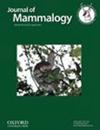北麂属 MHC II 类 DRB 等位基因的多样性
IF 1.6
3区 生物学
Q2 ZOOLOGY
引用次数: 0
摘要
主要组织相容性复合体(MHC)基因是监测物种适应性遗传和进化潜力的常用标记。在这项研究中,我们利用新一代测序技术研究了麂属动物MHC II类DRB基因座的遗传变异。通过对 102 个样本进行测序,鉴定出 25 个等位基因,其中 11 个为新等位基因。非同义突变与同义突变的相对比率(dN/dS)很高,表明该基因位点存在正选择信号。我们分析了北麂两个亚种内部和之间的遗传变异模式,并将其与之前发表的使用中性标记的研究结果进行了比较,为评估人口变化过程的影响提供了依据。我们的分析表明,在频率相似的不同种群中,等位基因很可能通过平衡选择得以维持,而且这种机制也适用于受遗传漂变影响较大的小规模孤立种群。本文章由计算机程序翻译,如有差异,请以英文原文为准。
Diversity of MHC class II DRB alleles in the Northern chamois genus Rupicapra
Major histocompatibility complex (MHC) genes are commonly used markers for monitoring adaptive genetic and evolutionary potential of species. In this study, we investigated genetic variation of the MHC class II DRB locus in the chamois genus Rupicapra by using next-generation sequencing. Sequencing of 102 samples led to the identification of 25 alleles, 11 of which are novel. The high ratio of the relative rates of nonsynonymous to synonymous mutations (dN/dS) suggests a signal of positive selection on this locus. We analyzed patterns of genetic variation within and among 2 subspecies of Northern Chamois and compared them to previously published studies using neutral markers to provide a basis for assessing the effects of demographic processes. Our analyses have shown that alleles are likely to be maintained by balancing selection in different populations with similar frequencies and that this mechanism also works in small, isolated populations that are strongly affected by genetic drift.
求助全文
通过发布文献求助,成功后即可免费获取论文全文。
去求助
来源期刊

Journal of Mammalogy
生物-动物学
CiteScore
3.30
自引率
5.90%
发文量
106
审稿时长
4-8 weeks
期刊介绍:
Papers are published on mammalian behavior, conservation, ecology, genetics, morphology, physiology, and taxonomy.
 求助内容:
求助内容: 应助结果提醒方式:
应助结果提醒方式:


